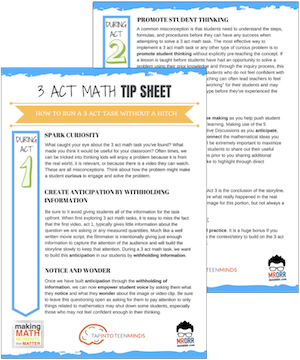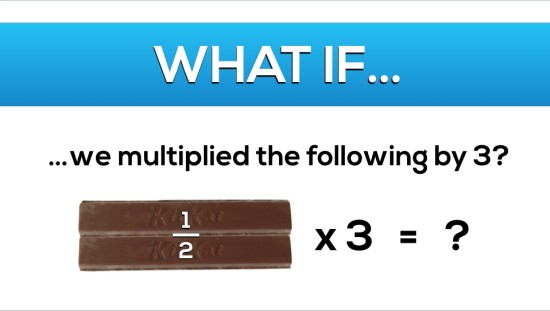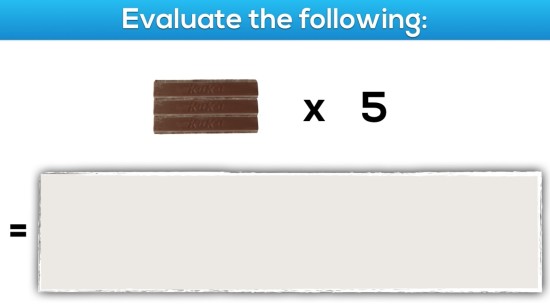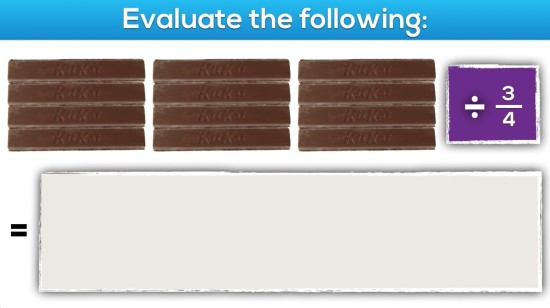Ontario Alignment By Overall Expectation
Adding/Subtracting and an Intro to Multiplying/Dividing Fractions
A colleague and good friend, Dave Burke, reached out to me recently for some ideas around adding and subtracting fractions. In particular, he was interested in trying to make the topic a little more enjoyable by adding some context. This was a challenge I was really eager to work on because working with fractions is such a sore spot for so many students and their teachers. In the past, I tried to help make dividing fractions less abstract by using the idea of dividing chocolate bars. With this in mind, I figured using chocolate bars for adding and subtracting would be a good starting point to move towards multiplication and division later.
Here are some expectations from the Grade 7 Ontario math curriculum that we’ll be aiming to touch on:
- Grade 7, NS2.01 – divide whole numbers by simple fractions and by decimal numbers to hundredths, using concrete materials (e.g., divide 3 by ½ using fraction strips; divide 4 by 0.8 using base ten materials and estimation);
- Grade 7, NS2.02 – use a variety of mental strategies to solve problems involving the addition and subtraction of fractions and decimals (e.g., use the commutative property: 3 x 2/5 x 1/3 = 3 x 1/3 x 2/5, which gives 1 x 2/5 = 2/5 ; use the distributive property: 16.8 ÷ 0.2 can be thought of as (16 + 0.8) ÷ 0.2 = 16 ÷ 0.2 + 0.8 ÷ 0.2, which gives 80 + 4 = 84);
- Grade 7, NS2.07 – add and subtract fractions with simple like and unlike denominators, using a variety of tools (e.g., fraction circles, Cuisenaire rods, drawings, calculators) and algorithms;
- Grade 7, NS2.08 – demonstrate, using concrete materials, the relationship between the repeated addition of fractions and the multiplication of that fraction by a whole number (e.g., 1/2 + 1/2 + 1/2 = 3 x 1/2);
I was surprised when I reviewed the grade 7 curriculum to find that the idea of dividing whole numbers by simple fractions was listed before adding and subtracting fractions. The more I thought about this, the more I like it. However, I stuck to adding/subtracting first.
So, let’s get started…
Task 1 – Adding Simple Fractions
Task 1, Act 1 – Introducing The Task
Show the students the video below:
Can’t see the video? Click here.
After watching the video, I have students take 30 seconds to discuss with their elbow partners what question(s) come to mind before sharing out with the group. I usually give them an open response question in Knowledgehook Gameshow to ensure all voices can be heard:
Can’t see the embedded Knowledgehook Gameshow question? Click here.
When the list of questions is exhausted, I then show them act 2…
Task 1, Act 2 – Revealing Some Information
Show the students the video below:
Can’t see the video? Click here.
Students quickly come to the conclusion that the question I am asking here is…
How many pieces of a whole KitKat bar are there?
I’ve been using Knowledgehook Gameshow as a way to keep my lessons interactive almost daily. The best feature is the upload solution tool (not available when embedded in websites) that allows me to share out student work instantly over the projector. I find using Gameshow makes it even easier for me to be the facilitator of the learning rather than the gatekeeper of knowledge. Typically, the solutions students share is enough to consolidate most tasks and I can minimize the amount of direct instruction I must deliver.
Task 1, Act 3 – The Solution
It is always nice to be able to show students the solution for a little celebration. This is where I see Gameshow could make an improvement. Have the option to add a “solution page” where you can insert media, rather than me having to open a video file or run a slide deck.
Can’t see the video? Click here.
Then, we continue on, slowly raising the bar on the complexity of the problems, but keeping the context the same.
Task 2 – Adding Fractions
Task 2, Act 2 – Revealing New Information
Then, show students this video:
Can’t see the video? Click here.
Students can then evaluate the expression.
Task 2, Act 3 – Watch the Answer!
Can’t see the video? Click here.
Task 3 – Adding and Subtracting Fractions
Task 3, Act 1 – Introducing the Problem
Can’t see the video? Click here.
Ask students to talk to their neighbours about what question we might ask here. The goal is to have them realize that they are going to need to do some addition and subtraction of fractions.
Task 3, Act 2 – Revealing Some Information
Can’t see the video? Click here.
Students can then evaluate the expression in Knowledgehook Gameshow.
Task 3, Act 3 – See the Answer!
Can’t see the video? Click here.
Consolidation: Adding/Subtracting Fractions:
Here are a few Knowledgehook Gameshow questions that might be useful for some practice prior to moving on:
Task 4 – Multiplying Whole Numbers By Simple Fractions
Task 4, Act 1 – Introducing the Problem
Can’t see the video? Click here.
Ask students to talk to their neighbours about what question we might ask here. Some students might say we are adding, which is great. However, I wonder if any students will notice that we are not only adding, but we are doing repeated addition (multiplication).
Students can then give their take on what they think will happen.
In order to “show” students this, play this clip:
Can’t see the video? Click here.
Task 4, Act 2 – Introducing the Problem
Now, it’s time for students to take this new idea and run with it. Show them this image:
Let students chat it out and then, when they are ready, they can give an open response of their thinking.
After exploring some of the open responses submitted by students, we can ask them to determine the answer to the problem.
Task 4, Act 3 – Watch The Answer
Show your students the video below:
Task 5 – Multiplying Whole Numbers By Simple Fractions
Task 5, Act 1 & 2 – Introducing Problem And Giving Information
Now, let’s give students an opportunity to try another problem involving multiplication. Show them this image:
Give them an opportunity to solve the problem by evaluating and interact with their classmates.
Task 5, Act 3 – Watch The Answer
Show students the solution video:
Task 6 – Dividing Whole Numbers By Simple Fractions
Task 6, Act 1 – Introducing Problem
Show students this video:
Students are then given some time to discuss what they think might be going on here and then they share out their thinking.
Task 6, Act 2 – Revealing More Information
Now, you can show the students some more information to get their wheels turning:
Then, students can solve and share out their solutions.
Task 6, Act 3 – Watch the Answer
Then, you can show students the video of the answer:
Task 7 – Dividing Whole Numbers By Simple Fractions
Task 7, Act 1 & 2 – Introducing Problem and Revealing Information
Show students this image:
Task 7, Act 3 – Watch The Answer
Show students this video:
DOWNLOAD THE TASK RESOURCES
Grab the task resource downloads so you can run this task without a hitch!

That’s it for now, but I do have a huge bag full of other chocolate bars that I intend to eventually use to make more problems involving fractions. Let me know how you like this one so I know if it is worth putting in the extra effort.
If you’re interested, you can try the full Knowledgehook Gameshow here or, you can copy the entire gameshow to your own Free Gameshow Account via the share link below:
Hope you enjoy using this task. If your and your students enjoyed using the task, be sure to leave a comment below and let me know how it went!
New to Using 3 Act Math Tasks?
Download the 2-page printable 3 Act Math Tip Sheet to ensure that you have the best start to your journey using 3 Act math Tasks to spark curiosity and fuel sense making in your math classroom!

Share With Your Learning Community:

About Kyle Pearce
I’m Kyle Pearce and I am a former high school math teacher. I’m now the K-12 Mathematics Consultant with the Greater Essex County District School Board, where I uncover creative ways to spark curiosity and fuel sense making in mathematics. Read more.
Access Other Real World Math Tasks
Search More 3 Act Math Tasks
Grade 2 [2.B1.1, 2.B1.3, 2.B2.1, 2.B2.2, 2.B2.3, 2.B2.4, Measurement - M1, Number Sense and Numeration - NS1, Number Sense and Numeration - NS2, Number Sense and Numeration - NS3]
Grade 3 [3.B1.5, 3.B2.1, 3.B2.3, 3.B2.7, Measurement - M1, Number Sense and Numeration - NS1, Number Sense and Numeration - NS3]
Grade 4 [4.B2.1, 4.B2.4, 4.E2.5, 4.E2.6, Measurement - M1, Number Sense and Numeration - NS1, Number Sense and Numeration - NS3, Patterning and Algebra - PA2]
Grade 5 [5.B1.7, 5.B2.9, 5.D1.3, 5.D1.6, 5.E2.6, 5.F1.2, 5.F1.5, Measurement - M1, Measurement - M2, Number Sense and Numeration - NS1, Number Sense and Numeration - NS3, Patterning and Algebra - PA2]
Grade 6 [6.B2.12, 6.B2.9, Data Management and Probability - DP3, Measurement - M1, Measurement - M2, Number Sense and Numeration - NS1, Number Sense and Numeration - NS2, Number Sense and Numeration - NS3, Patterning and Algebra - PA1, Patterning and Algebra - PA2]
Grade 7 [7.B1.3, 7.B1.4, 7.B1.7, 7.B2.2, 7.B2.3, 7.C1.1, 7.C1.2, 7.C1.3, 7.C1.4, 7.D1.6, Data Management and Probability - DP3, Geometry and Spatial Sense - GS1, Measurement - M1, Measurement - M2, Number Sense and Numeration - NS1, Number Sense and Numeration - NS2, Number Sense and Numeration - NS3, Patterning and Algebra - PA1, Patterning and Algebra - PA2]
Grade 8 [8.B1.4, 8.B2.5, 8.C1.1, 8.C1.2, 8.C1.3, 8.C1.4, Data Management and Probability - DP1, Data Management and Probability - DP3, Geometry and Spatial Sense - GS2, Measurement - M1, Measurement - M2, Number Sense and Numeration - NS1, Number Sense and Numeration - NS2, Number Sense and Numeration - NS3, Patterning and Algebra - PA1, Patterning and Algebra - PA2]
Grade 9 [9.B3.5, 9.C3.1, 9.C3.2, 9.C3.3]
Kindergarten [k.15.1, k.15.10, k.15.2]
MAP4C [Mathematical Models - MM1, Mathematical Models - MM2, Mathematical Models - MM3]
MAT1LMAT2LMBF3C [Data Management - DM1, Data Management - DM2, Geometry and Trigonometry - GT1, Geometry and Trigonometry - GT2, Mathematical Models - MM1, Mathematical Models - MM2, Mathematical Models - MM3]
MCF3M [Exponential Functions - EF2, Quadratic Functions - QF1, Quadratic Functions - QF2, Quadratic Functions - QF3, Trigonometric Functions - TF1, Trigonometric Functions - TF3]
MCR3U [Characteristics of Functions - CF1, Characteristics of Functions - CF2, Exponential Functions - EF2, Exponential Functions - EF3, Trigonometric Functions - TF3]
MCT4C [Exponential Functions - EF1, Trigonometric Functions - TF3]
MCV4U [Derivatives and Their Applications - DA2]
MDM4U [Counting and Probability - CP2, Organization of Data For Analysis - DA2, Probability Distributions - PD1, Statistical Analysis - SA1, Statistical Analysis - SA2]
MEL4EMFM1P [Linear Relations - LR1, Linear Relations - LR2, Linear Relations - LR3, Linear Relations - LR4, Measurement and Geometry - MG1, Measurement and Geometry - MG2, Measurement and Geometry - MG3, Number Sense and Algebra - NA1, Number Sense and Algebra - NA2]
MFM2P [Measurement and Trigonometry - MT1, Measurement and Trigonometry - MT2, Measurement and Trigonometry - MT3, Modelling Linear Relations - LR1, Modelling Linear Relations - LR2, Modelling Linear Relations - LR3, Quadratic Relations in y = ax^2 + bx + c Form - QR1, Quadratic Relations in y = ax^2 + bx + c Form - QR2, Quadratic Relations in y = ax^2 + bx + c Form - QR3]
MHF4U [Characteristics of Functions - CF3, Exponential and Logarithmic Functions - EL2, Exponential and Logarithmic Functions - EL3]
MPM1D [AG3, Analytic Geometry - AG1, Analytic Geometry - AG2, LR1, LR2, LR3, MG1, MG2, MG3, NA1, Number Sense and Algebra - NA2]
MPM2D [AG1, AG2, AG3, QR2, Quadratic Relations - QR3, Quadratic Relations - QR4, T2, T3]
Functions [F-BF.1, F-BF.3, F-IF.4, F-LE.1, F-LE.2, F-LE.3, F-TF.5]
Geometry [G-C.5, G-C.8, G-C.9, G-GMD.3, G-GMD.4, G-GPE.4, G-GPE.5, G-GPE.7, G-MG.1, G-MG.2, G-SRT.11]
Grade 1 [1.NBT.4, 1.OA.1, 1.OA.6, 1.OA.A.1, 1.OA.B.3, 1.OA.B.4, 1.OA.C.5, 1.OA.C.6]
Grade 2 [2.NBT.5, 2.NBT.B.5, 2.NBT.B.8, 2.NBT.B.9, 2.OA.2, 2.OA.A.1, 2.OA.B.2]
Grade 3 [3.MD.C.5, 3.NBT.2, 3.NF.1, 3.NF.2, 3.NF.3, 3.NF.A.1, 3.OA.1, 3.OA.5, 3.OA.9]
Grade 4 [4-MD.3, 4.MD.1, 4.MD.2, 4.NBT.6, 4.NF.3, 4.NF.5, 4.NF.6, 4.OA.1, 4.OA.5]
Grade 5 [5.B1.7, 5.D1.3, 5.D1.6, 5.MD.1, 5.MD.3, 5.MD.4, 5.MD.5, 5.NBT.2, 5.NBT.3, 5.NBT.6, 5.NBT.7, 5.NF.1, 5.NF.2, 5.NF.3, 5.NF.4, 5.NF.5, 5.OA.1, 5.OA.2, 5.OA.3]
Grade 6 [6.EE.1, 6.EE.2, 6.EE.5, 6.EE.6, 6.EE.7, 6.G.1, 6.G.2, 6.NS.1, 6.NS.3, 6.NS.6, 6.NS.B.3, 6.NS.C.6, 6.NS.C.7, 6.NS.C.8, 6.RP.1, 6.RP.2, 6.RP.3, 6.RP.A.1, 6.RP.A.2, 6.RP.A.3, 6.RP.A.3.C]
Grade 7 [7.EE.3, 7.EE.4, 7.EE.A.1, 7.G.3, 7.G.4, 7.G.6, 7.NS.A.1, 7.NS.A.2, 7.RP.1, 7.RP.3, 7.RP.A.2.B, 7.RP.A.3, 7.SP.2, 7.SP.5, 7.SP.6]
Grade 8 [8.EE.1, 8.EE.5, 8.EE.6, 8.EE.7, 8.EE.8, 8.F.2, 8.F.3, 8.F.4, 8.F.5, 8.G.5, 8.G.6, 8.G.7, 8.G.9, 8.SP.1]
Grade 9Kindergarten [K.CC.A.1, K.NBT.A.1, K.OA.A.1, K.OA.A.2, K.OA.A.3]
Practice [MP.1, MP.2, MP.3, MP.4, MP.6, MP.7]
Statistics & Probability [S-ID.6, S-MD.4]




Hey Kyle, This is such a great series of activities to meet the grade 7 curriculum expectations. I especially love the concrete and visual aspect. It really helps students understand order of operations. I am wondering if there needs to be a different video for Task 5 Act 3. It appears to be the Task 4 Act 3 video.
Thanks for all you do to make the rest of us look amazing!!
That was supposed to say it really helps students understand operations with fractions. My brain’s auto pilot clearly kicked in and my fingers typed order of operations by accident.
Hi Rhonda,
Thanks so much for stopping by! Glad to hear that you find the task useful in your quest to engage students and fuel their sense making!
Thanks for catching the video mix-up for Task 5, Act 3… ALL FIXED! 🙂
Hello, I downloaded the task resources but am a little confused. Is there a slide deck? I don’t see a file for that. Do I unzip the index file? I did that but still don’t see a slide deck file.
Also, I am confused as to what happened to Task 2, Act 1?
Hi – Love this activity. I have used it for a few years now. Thought I might try the Game show questions 6-11, but they do not seem to be accessible. When I use the links, I get a blank screen with “report a problem”. However, this report link is inactive. Any ideas?
Hello, I look forward to using this in the near future. I am having trouble accessing the Knowledgehook Gameshow. Is there anyway you can help me out?